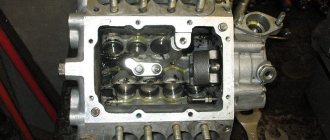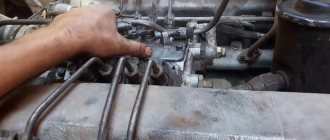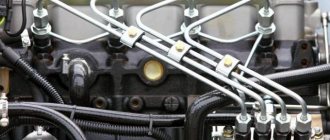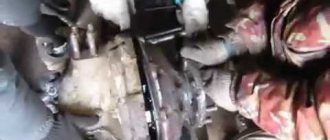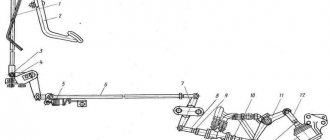If disturbances are observed in the functioning of the diesel unit of a KamAZ vehicle, then the cause of this may be a malfunction of the high pressure fuel pump. Our company offers professional restoration of normal operation of fuel injection pumps using the latest technologies and using modern equipment.
We employ only professional employees who know effective techniques for carrying out repair and restoration work of any complexity.
Estimated cost for services for repairing fuel injection pumps and adjusting fuel equipment for KamAZ diesel engines:
| Name of works | Cost in rub. |
| Injection pump diagnostics on a bench (without adjustment) | 1000 |
| Diagnostics of fuel injection pump on a bench (with adjustment) | 2500 |
| Repair of fuel injection pump with adjustment | From 2000 |
| Mechanical injectors YaMZ (per piece) | |
| Diagnostics | 50 |
| Adjustment | 250 |
| Replacing the sprayer (with adjustment) | 250 |
The cost of adjusting and repairing fuel injection pumps
| Name of injection pump | Number of sections | Engine | Applicability | Diagnostics on a stand without adjustment. | Diagnostics on a stand with adjustable | Maintenance | Major renovation |
| 60.5-30 | 6 | YaMZ-236 M2 | ——- | 1000 | 2500 | 2000 | 10000 |
| 60.5-40 | 6 | YaMZ-236A,A1 | ZIL, Bus LAZ | 1000 | 2500 | 2000 | 10000 |
| 80.5-30 | 8 | YaMZ-238M2 | KRAZ, MAZ, KAMAZ | 1000 | 3000 | 3000 | 12000 |
| 80.6-30 | |||||||
| 80.7-20 | 8 | YaMZ-238MM | URAL | 1000 | 3000 | 3000 | 12000 |
| 804.7-21 | 8 | YaMZ-238N,N1 | BAZ, HTZ | 1000 | 3000 | 3000 | 12000 |
| 805.5-30 | 8 | YaMZ-238DK | COMBINE DON | 1000 | 3000 | 3000 | 12000 |
| 805.5-40 | 8 | YaMZ-238BK | COMBINE DON | 1000 | 3000 | 3000 | 12000 |
| 805.7-30 | 8 | YaMZ-238ND2 | Tractor K-700A | 1000 | 3000 | 3000 | 12000 |
| 805.7-40 | 8 | YaMZ-238N4 | Tractor K-703MA | 1000 | 3000 | 3000 | 12000 |
| 806.5-40 | 8 | YaMZ-238D | MAZ | 1000 | 3000 | 3000 | 12000 |
| 806.6-40 | |||||||
| 133-20 | 6 | YaMZ-236NE2 | MAZ, Ural, ZIL | 1000 | 3000 | 2000 | 13000 |
| 173-11 | 8 | YaMZ-238DE | MAZ | 1000 | 3000 | 3000 | 15000 |
| 173-30 | |||||||
| 175-01 | 8 | YaMZ-7511.10 | MAZ | 1000 | 3000 | 3000 | 15000 |
| 175-40 | |||||||
| 4UTNI | 4 | —— | ——— | 1000 | 2000 | 2000 | 8000 |
Note:
The cost of repairing fuel equipment (HPF) does not include the cost of spare parts, removal and installation.
The cost of additional work, as well as urgency, is discussed individually.
The customer may be provided with a discount on contractual terms.
Warranty for fuel injection pump repairs is 6 months.
You can obtain more detailed information on the brands and models of fuel injection pumps that are subject to diagnostics and repair in our company from our managers:
tel: (495) 773-6-774
Self-repair of fuel injection pump
There are specific signs that indicate the need for fuel injection pump repair. Thus, repair of Kamaz fuel equipment may be required if:
- the dynamic characteristics of the car have deteriorated,
- fuel leaks form from the fuel injection pump or unknown extraneous noises are heard,
- the engine speed jumps or the smoothness of its operation has disappeared,
- there was an increase in fuel consumption,
- the engine refuses to respond to pressing the gas pedal,
- there is no fuel supply to the injector from the pump.
As for the repair itself, it can be current or major. So, if the plunger pairs work, then you can get by with routine repairs. In this case, a malfunction is found and eliminated by replacing worn-out spare parts. Then adjustments and bench tests are carried out. In the case of a major overhaul, the injection pump is completely disassembled to carry out a complete troubleshooting, after which reassembly, adjustment and the same bench tests are performed.
However, if repairing a Kamaz vehicle involves interfering with the operation of the fuel system, then a bench test of this unit is mandatory. Sometimes without such a check it is completely impossible to find out the cause of the breakdown. And the final stage of repair includes checking the functioning of the motor.
Devices for diagnosing fuel injection pump faults
As already mentioned, superficial diagnostics evaluates the presence or absence of extraneous noise in the injection pump. The presence of noise indicates that some kind of malfunction has occurred, but a specific “diagnosis” is not established in this way. A complete diagnosis requires a professional approach.
For professional diagnostics, specialized equipment is used, which can vary in degrees of modification or functions performed. The most popular device in this segment is the DD-2115. It “helps” in assessing plunger pairs and their technical condition. By the way, plunger pairs are very important for the correct operation of the injection pump, since they regulate the amount of injected fuel and its further distribution among the cylinders. The plungers are made of high-strength and corrosion-resistant chromium-molybdenum steel. Despite the improved properties of the material used, the part is still subject to wear. Failure of the plunger pair can be caused by low-quality fuel - after all, water has the greatest destructive effect on the plunger. A worn plunger pair must be replaced. The same is done with other worn spare parts.
You also need to understand that there are narrow-profile repair operations - such as welding a body or repairing a Kamaz fuel injection pump. Sometimes it can be difficult to find good specialists to do the work. However, this is quite possible if you use the recommendations of friends.
Fuel injection pump YAZDA 337.20 for KamAZ
It is the most common modification, which is still in demand among car enthusiasts. The production took place in Yaroslavl, where one of the machine-building plants was responsible for the production of the design.
The product is inexpensive and therefore one of the most affordable. Also among the advantages are:
- ease of assembly;
- reliability;
- no need for careful maintenance.
The pumps are able to withstand any load and any external influence, which suggests a long service life of the unit and its maintainability.
Diesel Fuel Information
Repair of KamAZ hydraulics
Depending on the conditions of use, according to GOST 305-82, the following grades of diesel fuel are established: L (summer), 3 (winter) and A (arctic). Their choice depends on the time of year and climatic conditions in the area of application.
Fuel L is used at air temperatures of 0 °C and above;
3 - at ambient air temperature - 20 °C and above (if the pour point of the fuel is not higher than - 35 °C), - 30 °C and above (if the pour point of the fuel is not higher than - 45 °C);
A - at ambient temperature - 50 °C and above.
The pour point of winter fuel corresponds to the last digit in its designation.
Summer fuel is more viscous; at subzero temperatures it releases paraffin in the form of flakes, and at 10 °C it loses its fluidity.
The last digit in the designation of summer diesel fuel characterizes the flash point.
The sulfur content in fuel characterizes its corrosive properties.
Depending on the sulfur content, diesel fuels are divided into two subgroups: with a sulfur mass fraction of no more than 0.2% and with a sulfur mass fraction of no more than 0.5% (for grade A fuel no more than 0.4%). Thus, fuels of the second subgroup contain approximately twice as much sulfur.
For KamAZ engines, fuel of both subgroups can be used, since they use motor oil with an additive that reduces the harmful effects of sulfur.
Let's look at examples of designation of diesel fuels:
L-0.2-40 GOST 305-82 - summer fuel, sulfur content up to 0.2%, flash point 40 ° C;
Z-0.5 minus 35 GOST 305-82 - winter fuel, sulfur up to 0.5%, pour point -35 ° C;
A-0.4 GOST 305-82 - arctic fuel, sulfur up to 0.4%.
One of the important indicators characterizing diesel fuel is flammability.
The fuel injected into the cylinder does not begin to burn immediately, but after some time, called the ignition delay period.
The longer the delay, the more fuel accumulates at the time of ignition and the faster the pressure in the cylinder subsequently increases. This leads to shock loads on the parts and is accompanied by metallic knocks (“hard” work).
The degree of “hardness” of a diesel engine depends on the ignition properties of the fuel and is characterized by the cetane number. The larger it is, the shorter the auto-ignition delay period, the easier the engine starts and the “softer” its operation.
Diesel fuels L, 3 and A have cetane numbers of at least 45.
Adjusting the diesel fuel injection pump.
High pressure devices and instruments
Adjusting high pressure fuel pumps
Injection pump device, types, principle of operation, adjustment and repair
Regulation of the injection pump must be carried out on special stands by highly qualified specialists. When adjusting the pump, use the bench injectors or injectors with which the pump was installed on the engine, marking the number of each injector in accordance with the cylinder. Before checking and adjusting the high-pressure pump, all injectors (if engine injectors are used) must be carefully checked and adjusted on a special stand in accordance with the specifications for the given type and model of injectors. After adjusting the pump, each injector should be installed on a cylinder corresponding to the pump section that was adjusted together with that injector.
The overall performance of the pump plunger pairs can be assessed using bench injectors adjusted to an injection start pressure 1.8…2 times higher than the nominal one. If in this case the pump provides supply, then the plunger pairs are in normal condition.
***
Cycle feed adjustment
The main adjustment of the fuel pump is to adjust the quantity and uniformity of the cyclic supply at nominal mode. To do this, the injection pump rail (or the dispenser for a single-plunger pump) is installed with a special screw in the nominal flow position. At the nominal rotation speed, the cyclic flow of all sections is measured, monitoring the fuel level in the measuring tubes for each section of the pump.
To control the amount of cyclic flow across pump sections, glass graduated test tubes are used, mounted on a test bench and connected to the outlet fitting of the section, or (in modern stands) on a display that visually displays the cyclic flow across sections of the fuel injection pump being tested. The cyclic flow must comply with the specifications for the pump and be adjusted for the specific engine model.
Deviation by sections (unevenness of supply) is allowed no more than 3...5%. Otherwise, for pumps of the 33 (KAMAZ) and 60 (ZIL) series, loosen the fastening of the section housing and turn it, moving the housing lock washer by one or two teeth. Some pumps (4UTNM, YAZDA, ChTZ) have special clamps for fastening sections, which, if necessary, loosen and correct the cyclic flow by turning the section body.
Adjusting the feed start angle
This angle is checked and adjusted on a bench.
In in-line pumps, a momentoscope is installed on the first section, and in V-shaped pumps of the 33 series - on the eighth section - a glass tube connected through a rubber pipe to a high-pressure fuel line (see figure). The rack is set to the nominal feed position and by manually rotating the pump shaft (by the injection advance clutch), the momentoscope tube is filled with fuel. By turning the shaft back and then slowly rotating it forward, determine the moment when the fuel surface (meniscus) in the momentoscope tube shakes. The rotation is stopped. In this case, the dial of the stand will show the angle to the axis of symmetry of the plunger drive cam. This angle must be within the specifications for that particular pump. So, for the eighth section of a series 33 pump (KAMAZ), this angle should be 42...43˚, and for the first section of 4UTNM pumps - 56˚.
After checking the first (or eighth) section, the torque scope is installed on the remaining sections according to the order of operation of the engine cylinders. The deviation of the injection advance angles by sections should not exceed 20′.
In order to adjust the advance angle of the start of flow in series 33 pumps (KAMAZ), the pusher heel is replaced, which is produced in 18 repair sizes. In pumps such as UTNM, TN, YAZDA, the plunger pusher screw is moved for these purposes. After adjusting the section, this screw is locked with a lock nut.
***
Diesel engine injector
Design and device
The pump is a dimensional mechanism consisting of a housing in which several cylinders and pistons are concentrated, as well as valves and other elements that contribute to reliable operation.
Today such devices are not produced. The cessation of production is explained by the pump’s non-compliance with environmental standards. Production of fuel injection pumps was discontinued in 2006. It is noteworthy that the operation of such a device is not prohibited by regulations, so the mechanism is considered quite popular and is still in demand.
The fuel pump is located on the engine and is located between the main cylinders in which fuel is transported. The injection pump is launched through the operation of the camshaft, the rotation of which is started by gears provided in the design.
The pump is equipped with:
- skeleton;
- a shaft with cams provided in the design;
- a sensor that monitors the speed of rotation;
- a clutch that is responsible for changing the mode of diesel fuel supply to the engine system.
The pump also has a drive mechanism that facilitates efficient operation of the mechanism. It is worth taking a closer look at several of the most significant design elements of the device.
skeleton
The frame is a separate structure in which several more elements are located. All of them are aimed at improving the functioning of the main mechanism.
The frame design includes:
- departments with additional pumps;
- shaft;
- regulator responsible for the number of rotation pulses.
The frame is made of aluminum alloy. The inlet channels are also made of this material. Additionally, the design provides voids into which sections of the pump or bearing shaft can be installed, if necessary.
There is a lid at the top of the frame. Mechanisms are attached to it, due to which it is possible to control the number of revolutions of the regulator and the fuel section plate. The front part of the structure contains a pipe equipped with a valve. The valve is made in the shape of a ball.
The frame is capable of withstanding fuel pressure ranging from 0.06 to 0.08 MPa. At the bottom of the product there is an empty space intended for mounting a shaft with cams.
Shaft with cams
This structural element is designed to impart displacement to pump elements, including plunger pairs. Due to this, it is possible to organize the transportation of fuel liquid inside the chambers. Steel is used as the material for manufacturing the shaft. Additionally, surfaces under load are calcined.
The shaft rotates due to two bearings provided in its design. The product is protected from possible leaks by a special cuff made of high-quality rubber. The front end of the structure drives the clutch, which is responsible for the injection angle. When in motion, it sets the direction of the angle and ensures timely injection of diesel fuel into the desired cylinder.
As the shaft rotates, it transmits pressure to the pushers and pump plungers. The pressure is transmitted to the latter by using the heels. Changing the thickness of the heels helps adjust the nature of the fuel supply. The greater the thickness, the earlier the injection will be carried out, and vice versa.
Pump departments
Construction of several elements. There are several of them in the injection pump. Due to the work of the departments, fuel is dispensed and transported to the injectors. Moreover, each pump section includes:
- skeleton;
- a pair of pistons and cylinders;
- bushing for turning;
- elastic elements;
- pressure injection valve;
- pusher
The frame of the pump section is equipped with a flange. It ensures reliable fixation of the section with the pump. Fastening is carried out using special pins. The holes for installing fasteners are oval and can be adjusted. This is provided in order to ensure a uniform supply of diesel fuel to each compartment.
A plunger pair is a combination of a cylinder and a piston. It takes part in cutting off diesel fuel and its subsequent transportation by creating the necessary pressure. The parts of the pair are precision. For their manufacture, steel is used, to which chromium and molybdenum are added. Additionally, to strengthen the material, the steel is quenched and cooled with nitrogen.
Radial grooves are located along the axis of the plunger. If necessary, they are able to change the direction of flow of diesel fuel in a timely manner. In the event of a breakdown, it becomes necessary to replace the elements, but this cannot be done individually. The plunger pair changes entirely.
device and adjustment Auto-Moto24.ru
Cylinder misfires, self-diagnosis and repair
In this article we will talk about the KAMAZ truck and in particular about the high pressure fuel pump. This unit is an important element in the system of any diesel engine. If the fuel injection pump malfunctions, the engine simply stops working, so the owner or mechanic who services the KAMAZ needs to know the device, its operating principle and steps to adjust the fuel pump.
Design and principle of operation of the unit
The manufacturing plant equips KAMAZ vehicles with diesel engines that comply with Euro-2 standards. In practice, during operation, such motors showed themselves in the best light, primarily due to the reliability of the fuel injection pump unit. Here is a diagram that describes the structure of the fuel pump and the designation of its parts.
Kamaz injection pump device
1 – aluminum alloy body; 2 – drive gear; 3 – cracker; 4 – drive gear flange; 5 – key; 6 – drive of the booster pump in the form of an eccentric; 7 – nut; 8 – intermediate gear; 9 – finger; 10 – regulator cover; 11 – regulator gear; 12 – load holder; 13 – load axis; 14 – cargo; 15 – thrust ball bearing; 16 – coupling; 17 – finger; 18 – top cover; 19 – spring lever; 20 – bypass valve; 21 – rack bushing; 22 – rack; 23 – clutch regulating fuel injection advance; 24 – nut; 25 – key; 26 – self-clamping type sealing coupling; 27 – bearing cover; 28 – roller bearing; 29 – cam shaft; 30 – pusher roller; 31 – thrust bushing; 32 – pusher heel; 33 – spring; 34 – plunger; 35 – inlet; 36 – section body; 37 – discharge valve; 38 – fitting; 39 – plunger bushing; 40 – rack lever.
The principle of operation is that diesel fuel comes from the fuel tank, which is filtered through a fine filter. The fuel pump provides supply pressure and directs flammable liquid directly to the injection pump. Following the operating cycles of the piston group, diesel fuel is distributed through the tubes to the injectors. The latter, in turn, spray the combustible mixture into the combustion chamber.
Residual diesel fuel, as well as excess air, are returned back to the tank. The flammable mixture, which has passed through the area between the sprayer and the needle, accumulates in the drain tubes.
The injection pump is complemented by a low pressure pump. It is designed in the form of a piston mechanism and is located on the regulator cover. The camshaft from the high pressure pump drives the low pressure pump. An automatic type clutch is located at the end, which ensures advance of diesel fuel injection. Its presence is due to a change in the crankshaft rotation speed.
Adjusting the injection pump
To adjust the high pressure fuel pump, you must:
- washing with special means to remove dirt;
- checking the injection advance, which is carried out according to the corresponding marks;
- checking the low pressure bypass valve;
- the valve is unscrewed in the closed position;
- the upper part of the valve is hammered to force it down so that the bypass hole closes;
- adjust the cyclic feed - unscrew or tighten;
- correct the idle speed by adjusting the same cyclic feed;
- normal idle speed corresponds to 770-780 rpm;
- adjust the hydraulic corrector by turning it counterclockwise or vice versa.
Kamaz injection pump: design and adjustment
How the injection pump system works
The Kama Automobile Plant produces its trucks equipped with a diesel engine. They comply with the Euro-2 environmental standard. The production of such power units has been prohibited in Russia since 2006, but they can still be used if they were produced earlier.
Over a long period of operation, they showed their best side and became famous for their reliability and durability. Much of the credit for this goes to the high-quality assembly of this unit.
The KAMAZ Euro 2 injection pump device includes the following main components:
Injection pump device KAMAZ Euro 2
- aluminium case;
- bypass valve;
- clutch that controls fuel injection advance;
- roller bearing;
- camshaft;
- plunger;
- inlet;
- discharge valve;
KamAZ is equipped with Euro-2 fuel injection pumps from two manufacturers - domestic and foreign (Bosch). In practice, the first option turned out to be more acceptable, since it is not afraid of harsh climatic conditions and is cheaper, unlike the German one.
